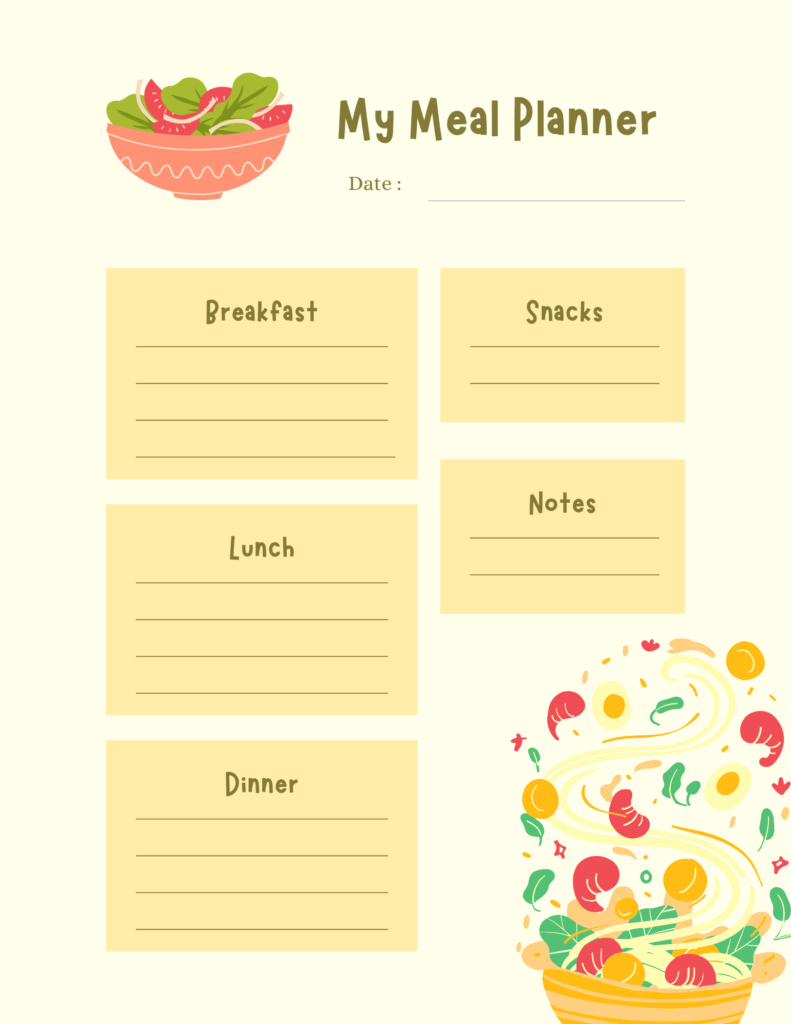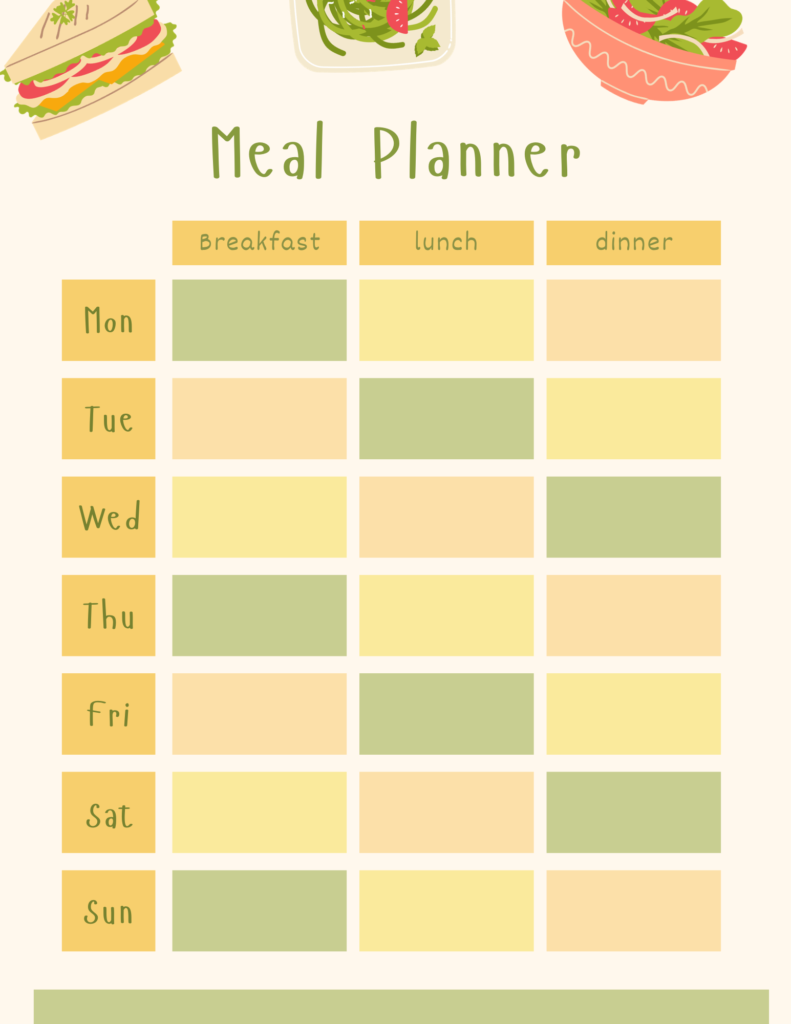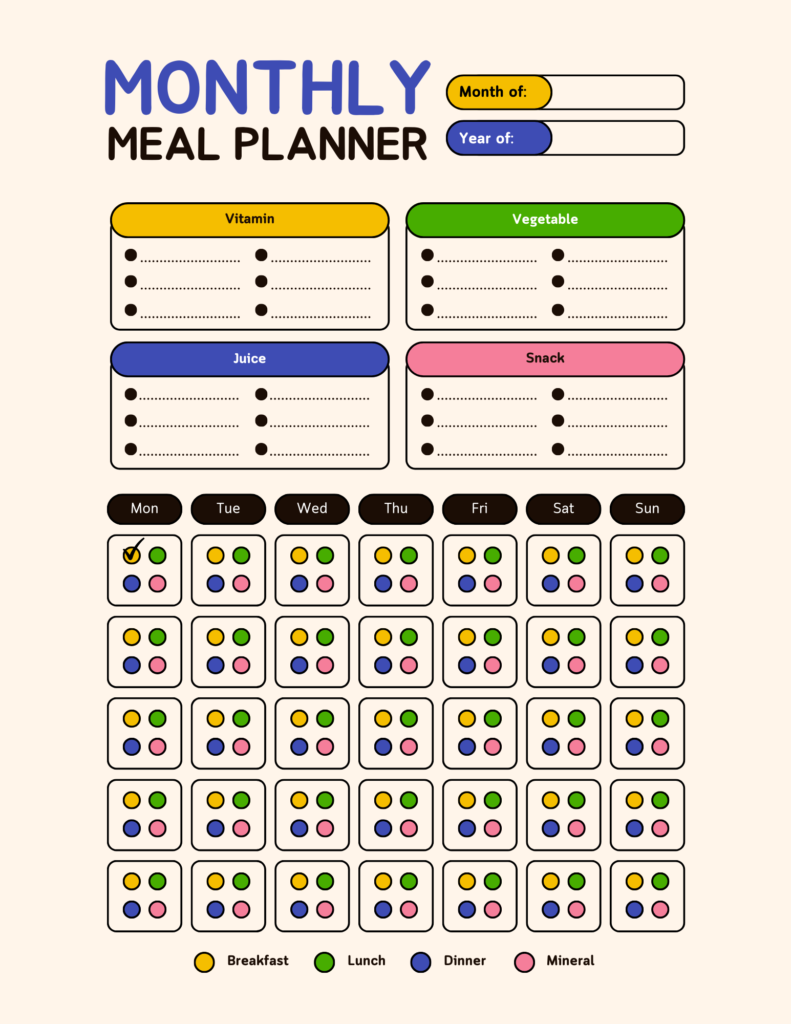In the whirlwind of modern life, where each day seems to bring a new challenge, the art of meal planning and preparation stands as a beacon of control and efficiency. The importance of this practice extends far beyond the mere act of deciding what to eat. It’s a strategic approach to nourishing our bodies, managing our time, and optimizing our health.
In today’s fast-paced world, the luxury of leisurely preparing meals is often a rarity. We juggle multiple responsibilities – careers, family, education, and social commitments – all vying for our precious time. Amidst this bustling backdrop, meal planning and prep emerge as vital tools for maintaining a balanced lifestyle. They not only streamline our daily routines but also alleviate the stress of last-minute decisions, often leading to healthier and more economical food choices.
However, the concept of meal planning is more than just a one-size-fits-all solution. It’s a canvas, diverse and adaptable, much like the individuals it aims to serve. Our guide recognizes this element and has been thoughtfully created to be suitable for a wide range of dietary choices and lifestyles. Whether you’re a busy professional seeking quick, nutritious meals, a parent aiming to balance a family’s varied tastes, or someone exploring a special diet such as vegan, keto, or gluten-free, this guide is your ally.
Our journey through the realms of meal planning and prep will not only provide you with practical strategies and templates but also delve into the nuances of tailoring these plans to fit your unique life circumstances. We understand that each person’s dietary needs, time constraints, and cooking skills are distinct. Thus, this guide is designed to be your personalized roadmap, leading you toward a more organized, health-conscious, and enjoyable culinary experience.
Embark on this journey with us as we navigate the complexities of meal planning and prep. Together, we’ll transform this seemingly mundane task into an empowering routine that resonates with your lifestyle, elevates your well-being, and brings a renewed zest to your daily meals.
In This Article
Section 1: The Basics of Meal Planning
Subsection 1.1: Understanding Your Dietary Needs
Tailoring Meal Plans to Different Dietary Requirements
In the quest to master meal planning, the first and perhaps most crucial step is understanding and respecting your dietary needs. This understanding is not merely about adhering to personal taste preferences but about recognizing and responding to the unique requirements your body has for nourishment and energy.
- Identifying Dietary Preferences and Restrictions:
- Vegan and Vegetarian: For those who exclude animal products, either for ethical, environmental, or health reasons, the focus is on obtaining essential nutrients like protein, iron, and B12 from plant-based sources.
- Gluten-Free: Essential for individuals with celiac disease or gluten sensitivity, this diet requires meticulous reading of labels to avoid gluten in wheat, barley, and rye.
- Keto and Low-Carb: Popular for weight loss and blood sugar management, these diets emphasize high-fat and low-carbohydrate foods, requiring careful balancing of macronutrients.
- Addressing Allergies and Intolerances:
- Understanding common food allergens (like nuts, dairy, and shellfish) and learning to identify them in ingredient lists is vital for those with allergies.
- For food intolerances (like lactose intolerance), meal plans should include suitable alternatives that don’t trigger symptoms.
- Cultural and Ethical Considerations:
- Respecting cultural dietary practices and ethical choices is integral to creating a meal plan that is not only nourishing but also aligns with personal beliefs and traditions.
The Role of Nutrition in Meal Planning
Nutrition is the cornerstone of effective meal planning. It’s about striking a balance between taste, convenience, and nourishment.
- Balancing Macronutrients:
- A well-rounded meal plan incorporates the right balance of carbohydrates, proteins, and fats. This balance varies based on dietary preferences, health goals, and individual metabolic needs.
- Incorporating Micronutrients:
- Paying attention to vitamins and minerals is just as crucial. A diverse meal plan ensures a range of fruits, vegetables, grains, and proteins to cover the spectrum of essential micronutrients.
- Meeting Caloric Needs:
- Calorie counting is not just for weight management. Understanding caloric needs based on lifestyle, age, gender, and activity level is essential for a meal plan that fuels the body adequately.
- Hydration and Dietary Fiber:
- Often overlooked, adequate hydration and dietary fiber are vital for digestive health and overall well-being. They should be integral components of any meal plan.
In the subsequent sections, we’ll dive into how to translate this understanding of dietary needs and nutrition into a practical, enjoyable meal plan that fits seamlessly into your lifestyle. This foundational knowledge sets the stage for making informed, health-conscious decisions in your culinary journey.
Subsection 1.2: Setting Realistic Goals
Aligning Meal Planning with Lifestyle and Time Constraints
The success of meal planning hinges on its feasibility within the context of your daily life. Realistic goal setting is the bridge that connects nutritional knowledge to a practical, sustainable meal planning routine.
- Understanding Your Time Budget:
- Assessing your weekly schedule to identify how much time you can realistically dedicate to meal planning, shopping, and cooking is crucial. This assessment should include work, family commitments, and leisure activities.
- Time-efficient strategies, such as batch cooking or using slow cookers, can be incorporated for those with tighter schedules.
- Lifestyle Integration:
- Meal planning should complement, not complicate, your lifestyle. For active individuals, this might mean portable and energy-dense meals, while a sedentary lifestyle might call for lighter, nutrient-rich options.
- Special considerations, like planning for social events or travel, ensure that your meal planning is adaptable and resilient.
Balancing Health Goals with Pleasure in Eating
A sustainable meal plan is one that harmoniously balances health objectives with the enjoyment of food. It’s not just about what you eat, but how you eat.
- Health Goals:
- Whether it’s weight management, improving heart health, or managing a medical condition, your meal plan should align with these objectives without being overly restrictive.
- Incorporating a variety of foods and flavors keeps the diet nutritionally diverse and mentally engaging, helping to avoid the pitfall of dietary boredom.
- Culinary Enjoyment:
- Pleasure in eating is a critical component of a sustainable meal plan. This involves experimenting with recipes, exploring new ingredients, and savoring each meal.
- Mindful eating practices, like savoring flavors and eating without distractions, enhance the dining experience and can lead to better satiety and portion control.
- Flexibility and Forgiveness:
- A realistic meal plan allows for flexibility. Occasional indulgences or deviations from the plan should be seen not as failures but as a normal part of a balanced lifestyle.
- Cultivating a non-restrictive mindset helps in maintaining a healthy relationship with food and prevents the cycle of guilt and binge eating.
In the next sections, we will explore how to translate these goals into actionable steps, creating a meal plan that is both nourishing and delightful, fitting seamlessly into the mosaic of your daily life. Remember, the best meal plan is the one that you can stick to consistently while enjoying the journey of eating well.
Section 2: Crafting Your Meal Plan
Subsection 2.1: Deciding What to Eat
Building a Varied and Balanced Menu
The foundation of a successful meal plan lies in creating a menu that is as diverse as it is balanced. This factor ensures that your meals are not only nutritious but also appealing and enjoyable.
- Variety in Cuisine and Ingredients:
- Embrace a global palate. Incorporating dishes from different cuisines not only adds excitement to your meals but also introduces a range of nutrients.
- Experiment with a variety of proteins, grains, fruits, and vegetables. This option not only caters to different nutritional needs but also helps in reducing meal monotony.
- Balanced Meal Composition:
- Each meal should strive for a balance of macronutrients: a good source of protein, a portion of carbohydrates, and some healthy fats.
- Remember to include the micronutrients. Include a colorful array of veggies and fruits to ensure a spectrum of vitamins and minerals.
- Portion Control:
- Understanding portion sizes is key to a balanced diet. Use visual cues (like the size of your fist for carbs or the palm of your hand for protein) to gauge appropriate portions.
- Portion control is not just about weight management; it’s about ensuring a balanced intake of different food groups.
Seasonal and Budget-Friendly Choices for Meal Planning
Eating well doesn’t have to be expensive or complicated. Seasonal and budget-friendly choices can enrich your meal plan both nutritionally and economically.
- Seasonal Eating:
- Choose from vegetables and fruits that are in season. They are not only fresher and more nutritious but also more affordable.
- Seasonal eating adds a natural variety to your diet and aligns your eating habits with the environmental cycle.
- Budget-Conscious Planning:
- Plan meals around sales and discounts at your local grocery stores. This can significantly lower your food expenses.
- Consider buying in bulk for staples or non-perishable items, and explore cost-effective protein sources like legumes and eggs.
- Reducing Food Waste:
- Plan to use ingredients in multiple meals throughout the week. For example, a roast chicken can be used in sandwiches, salads, and soups.
- Understanding how to store different foods properly can extend their shelf life and reduce waste.
As we move forward, remember that the goal of meal planning is not just to eat well but to do so in a way that is both enjoyable and sustainable. A well-crafted meal plan respects both your palate and your pocket. The next subsection will delve into practical templates and customization tips to bring your meal plan to life.
Subsection 2.2: Meal Plan Templates
Providing Downloadable Templates for Daily, Weekly, and Monthly Meal Planning
A crucial aspect of effective meal planning is having a structured approach. To facilitate this, providing accessible, user-friendly templates is essential. These templates act as a guide, helping to organize and streamline the meal planning process.
- Daily Meal Planning Template:
- Ideal for those who prefer day-by-day planning or have fluctuating schedules.
- Includes sections for your breakfast, lunch, dinner, and snacks, with additional space for noting down specific recipes or food items.

- Weekly Meal Planning Template:
- Suitable for individuals or families looking to plan their meals more comprehensively.
- Features a week-at-a-glance view, allowing for a balanced distribution of meals and ingredients across the week.

- Monthly Meal Planning Template:
- Best for advanced planners and those who like to have a broader overview.
- Helps in aligning meal plans with long-term goals, budgeting, and shopping strategies.

These templates should be easily downloadable and printable. Hover over the image for a larger display image.
Customization Tips for Different Lifestyles
Tailoring meal plans to fit various lifestyles ensures that they are practical and sustainable. Here are some customization strategies for different groups:
- Busy Professionals:
- Focus on quick and easy recipes that require minimal preparation.
- Incorporate meal prep on Sundays or a designated day to prepare and portion meals for the week.
- Utilize leftovers creatively to minimize cooking time on busy days.
- Families:
- Plan meals that are kid-friendly and adaptable to different taste preferences.
- Engage family members in the planning process, making it a collaborative and educational activity.
- Batch cook and freeze portions for hectic days.
- Health-Conscious Individuals:
- Include detailed nutritional information in the meal plan for calorie and macronutrient tracking.
- Focus on balanced meals with a variety of lean proteins, whole foods, and plenty of fruits and vegetables.
- Plan for post-workout meals or snacks if regular exercise is part of the routine.
- Students and Budget-Conscious Planners:
- Create meal plans that utilize affordable ingredients and minimize food waste.
- Focus on simple, nutritious meals that require basic cooking equipment.
- Plan for meals that can be easily packed and carried to school or work.
- Special Diets (Vegan, Gluten-Free, etc.):
- Tailor meal plans to accommodate specific dietary restrictions, ensuring nutritional completeness.
- Include a variety of alternative ingredients to maintain diversity in diet.
Section 3: Smart Grocery Shopping
Subsection 3.1: Efficient Shopping Tips
Creating a Shopping List Aligned with Your Meal Plan
A well-organized shopping list is the cornerstone of efficient grocery shopping. It streamlines the process, saves time, and ensures that you have all the necessary ingredients for your planned meals.
- List Organization:
- Categorize your list according to the layout of your grocery store (e.g., produce, dairy, meats, dry goods). This organization minimizes backtracking and saves time.
- Consider using digital apps that allow you to create and share lists, making the process more efficient and eco-friendly.
- Inventory Check:
- Before writing your shopping list, do a quick inventory of what you already have. This helps avoid buying duplicates and encourages the use of items you already possess.
- Regularly organizing your pantry and fridge also aids in keeping track of what needs to be replenished.
- List According to Meal Plan:
- Ensure that your list reflects the ingredients needed for your meal plan. Stick to the prepared shopping list to avoid impulse buys that can derail your meal plan and budget.
- Planning for Flexibility:
- Include a few versatile ingredients that can be used in multiple dishes or for last-minute meal changes.
- Have some non-perishable backups in your pantry for days when plans change unexpectedly.
Budgeting and Cost-Saving Strategies
Sticking to a budget while grocery shopping doesn’t mean compromising on the quality of your meals. With smart strategies, you can eat well without overspending.
- Seasonal Shopping:
- If feasible, buy veggies and fruits during the peak of their growing season. They’re not only less expensive, but they’re also at their optimum in flavor and nutrition.
- Farmers’ markets are excellent places to discover fresh, seasonal produce at reasonable prices.
- Bulk Buying:
- Purchase non-perishable items or items you use frequently in bulk. This is often more cost-effective.
- Be cautious to only buy perishables in bulk if you’re sure you can use them before they spoil.
- Store Brands and Sales:
- Opt for store brands when possible. They are often cheaper than name brands and of similar quality.
- Take advantage of available promotions and discounts, but only purchase what you need and will use.
- Minimizing Waste:
- Plan to use perishable items first and have a strategy for leftovers. This approach reduces food waste and saves money.
- Freezing excess perishables or cooking in batches can also help in utilizing ingredients before they go bad.
In the next subsection, we’ll explore how to choose quality ingredients, an essential aspect of ensuring that your meals are not only cost-effective but also nutritious and delicious.
Subsection 3.2: Choosing Quality Ingredients
Tips for Selecting Fresh Produce and Quality Ingredients
Selecting high-quality ingredients is crucial for creating nutritious and flavorful meals. Knowing how to identify the freshest produce and the best ingredients can elevate your cooking and contribute to a healthier diet.
- Selecting Fresh Produce:
- Look for fruits & vegetables that are firm, radiant in color, and free of bruises or blemishes. Freshness often equates to maximal nutritional value.
- Smell is a good indicator of freshness, particularly for fruits. A ripe, sweet aroma usually signifies a good choice.
- For leafy greens, choose bunches that look crisp and green, avoiding any that are wilted or yellowed.
- Choosing Meat and Seafood:
- For meats, look for cuts that are moist but not slimy, with a consistent color and no overpowering odor.
- With seafood, the smell test is crucial; fresh fish should maintain the sea’s fresh aromas, not fishy. Eyes should be clear and bright, and the flesh should spring back when pressed.
- Dairy and Eggs:
- Always check the expiration dates on all dairy products and choose the freshest available.
- For eggs, ensure the shells are intact and feel heavy for their size, indicating freshness.
- Bulk and Dry Goods:
- For grains, legumes, and nuts, look for signs of moisture or bugs, which indicate poor quality.
- Whole grains and unprocessed options are usually a healthier choice, providing more fiber and nutrients.
Understanding Food Labels and Nutritional Information
Interpreting food labels and nutritional information is key to making informed choices about the ingredients you include in your meal plan.
- Reading Ingredient Lists:
- The order of ingredients can tell you about the product’s composition. The ingredients are presented on the basis of quantity, from highest to lowest.
- Be wary of long lists with unrecognizable ingredients, as these can indicate a high level of processing.
- Nutritional Facts:
- Pay attention to serving sizes and the number of servings per container to accurately assess calorie and nutrient intake.
- Look at the amounts of saturated fat, sodium, sugars, and fiber. Opt for items with lower saturated fats, less sodium, and sugars but higher in fiber.
- Health Claims and Labels:
- Be cautious of health claims on packaging. Terms like “natural” or “healthy” are not strictly regulated and can be misleading.
- For special diets (e.g., gluten-free, organic), look for certification labels that guarantee compliance with specific standards.
- Allergen Information:
- Check for allergen warnings if you or someone in your household has food allergies. This information is usually highlighted on the label.
By choosing quality ingredients and understanding what goes into the products you buy, you can ensure that your meal plan is not only delicious but also aligns with your health and nutritional goals. In the following sections, we will delve into the practical aspects of meal preparation and cooking, turning these carefully selected ingredients into delightful, nourishing meals.
Section 4: The Prep Process
Subsection 4.1: Batch Cooking and Storage
Techniques for Efficient Batch Cooking
Batch cooking is a strategic approach to meal preparation that saves time and ensures you have healthy meals at hand throughout the week. It involves cooking larger quantities of food at once, which can then be stored and used over several days.
- Planning for Batch Cooking:
- Choose recipes that are suitable for large-scale cooking, like stews, casseroles, and grain-based dishes.
- Plan a mix of recipes that can offer variety throughout the week, considering how well they keep when refrigerated or frozen.
- Efficient Cooking Methods:
- Utilize kitchen appliances like slow cookers, pressure cookers, and ovens to cook multiple items simultaneously, saving time and energy.
- Opt for one-pot meals, which reduce both cooking time and cleanup effort.
- Maximizing Ingredients:
- Prepare a base ingredient in bulk (like grilled chicken, roasted vegetables, or cooked grains) that can be used in different recipes throughout the week.
- Cook components that can be easily transformed into various meals, offering flexibility and variety.
Safe Food Storage Practices
Proper storage is the key element to maintaining the freshness and safety of your batch-cooked meals. It helps preserve flavor and nutrients and prevents food spoilage or contamination.
- Cooling and Storing:
- Allow all cooked food to cool to room temperature before refrigeration to prevent bacterial growth.
- Divide large quantities into smaller portions in airtight containers for quicker cooling and easier usage.
- Refrigeration and Freezing:
- Use clear, labeled containers with dates to keep track of when food was cooked, following a first-in, first-out approach.
- Understand the shelf life of different cooked foods – while some dishes can be refrigerated for a few days, others may be better suited for freezing for longer storage.
- Thawing and Reheating:
- Safely thaw frozen meals in the refrigerator or use a microwave for quicker defrosting.
- When reheating, ensure the food reaches the proper temperature to kill any potential bacteria. Stir food evenly to distribute heat.
- Avoiding Cross-Contamination:
- Store raw and cooked foods using individual packaging to prevent cross-contamination.
- Always use separate chopping blocks and utensils for raw meats and other ingredients.
Implementing these batch cooking and storage techniques can revolutionize your meal prep process, making it more efficient and effective. This approach not only saves time during busy weekdays but also ensures that you have access to healthy, homemade meals aligning with your dietary goals. The next subsection will delve into time-saving cooking strategies, further enhancing your meal prep efficiency.
Subsection 4.2: Time-Saving Cooking Strategies
Quick and Healthy Cooking Methods
Efficiency in the kitchen doesn’t mean sacrificing health or flavor. By utilizing quick and healthy cooking methods, you can prepare nourishing meals in less time.
- Stir-Frying and Sautéing:
- These methods are quick and preserve the nutrients in vegetables better than longer cooking processes.
- Use a wok or a large skillet to stir-fry or sauté vegetables, lean meats, or tofu with a small amount of healthy oil, like olive or avocado oil.
- Steaming:
- The steaming process is a gentle cooking method that retains most of the nutrients in vegetables and fish.
- Use a steamer basket or an electric steamer. It’s fast, requires minimal supervision, and doesn’t require added fats.
- Grilling and Broiling:
- These techniques add a rich flavor to meats, fish, and vegetables without needing excess oil.
- They are quick, with most foods cooking in under 20 minutes, and they allow fats to drip away from the food, reducing calorie intake.
- Pressure Cooking:
- Ideal for legumes, grains, and tougher cuts of meat. Pressure cooking drastically reduces cooking time and preserves nutrients and flavor.
- Modern pressure cookers are safe and user-friendly, making them a valuable tool for quick meal preparation.
Kitchen Organization Tips for Streamlined Cooking
A well-organized kitchen is an essential ingredient in the recipe for quick and efficient cooking. Streamlining your kitchen setup saves time and reduces stress during meal preparation.
- Organizing Ingredients and Tools:
- Keep frequently used ingredients (like oils, spices, and utensils) within easy reach to minimize time spent searching.
- Organize your pantry and fridge by type of food and frequency of use, placing items you use most at the front.
- Prep Work:
- Do as much prep work as possible ahead of time. This includes washing and chopping vegetables, marinating meats, and pre-measuring ingredients.
- Consider investing in a good set of knives and kitchen tools like graters and vegetable peelers to make prep work quicker and easier.
- Clean As You Go:
- Keeping your workspace clean and clutter-free reduces stress and makes cooking more enjoyable.
- Wash utensils and cutting boards while your meal is cooking to avoid a pile-up of dishes at the end.
- Use of Technology:
- Digital kitchen scales, timers, and thermometers can make cooking more precise and efficient.
- Apps and smart home devices can help in monitoring cooking times and keeping track of recipes.
Implementing these time-saving cooking methods and kitchen organization tips can significantly reduce the time spent in the kitchen while still allowing you to enjoy healthy, homemade meals. The efficiency gained through these strategies not only frees up time for other activities but also makes the process of cooking less daunting and more enjoyable.
Section 5: Staying Motivated and Adaptable
Subsection 5.1: Overcoming Meal Prep Challenges
Managing Time Restrictions and Lack of Motivation
One of the biggest hurdles in maintaining a consistent meal prep routine is managing time constraints and staying motivated. Overcoming these challenges is crucial for sustaining healthy eating habits.
- Efficient Time Management:
- Maximize Short-Time Slots: Utilize small pockets of time for prep work. Chopping vegetables or marinating meat can be done in brief intervals.
- Plan for the Whole Week: Allocate a specific day for bulk cooking. This reduces daily cooking time and decision fatigue.
- Staying Motivated:
- Set Realistic Goals: Start with manageable tasks. If daily meal prep seems overwhelming, begin with preparing meals for a couple of days.
- Track Progress: Prepare a journal or use an app to track the meals you’ve prepared and the benefits you’re experiencing, like saving money or feeling healthier.
Strategies for Keeping Meal Prep Interesting
Keeping the meal prep process engaging and varied is essential to avoid monotony, which can quickly derail your efforts.
- Experiment with New Recipes and Ingredients:
- Introduce one new recipe each week to diversify your menu.
- Experiment with different cuisines and flavors to keep your taste buds excited.
- Involve Others:
- Share the meal prep process with family members or roommates. It’s a great way to spend time together and share responsibilities.
- Organize meal prep “parties” with friends where you can cook and share large batches of food.
- Presentation and Plating:
- The visual appeal of food can dramatically enhance the eating experience. Try different plating techniques or garnishes to make meals more enticing.
- Invest in good-quality food containers. Attractive storage can make mealtime more appealing and can keep food fresher.
- Learning and Inspiration:
- Stay inspired by following food blogs, watching cooking shows, or reading cookbooks.
- Attend cooking classes or webinars to learn new techniques and ideas.
Incorporating these strategies can help overcome the common challenges of meal prep. It’s about finding a balance that works for you, making the process enjoyable, and aligning it with your lifestyle. As we move to the next subsection, we’ll discuss how to adapt your meal plan to fit changing schedules and circumstances, ensuring that your meal prep journey is both flexible and resilient.
Subsection 5.2: Adjusting Your Plan
Flexible Meal Planning for Changing Schedules
Adaptability in meal planning is key to maintaining it as a sustainable practice, especially when dealing with the unpredictability of daily life. A flexible meal plan can accommodate changes without causing stress or derailing your dietary goals.
- Build-in Flexibility:
- Adaptable Recipes: Select recipes that can be modified based on the ingredients you have on hand or the time available.
- Backup Options: Have a few quick and easy meal options ready for days when time is limited, such as pre-prepared salads, frozen meals, or healthy canned foods.
- Plan for the Unexpected:
- Adjustable Portions: Cook meals that can be easily scaled up or down. This way, if your schedule changes, you can accommodate additional guests or have leftovers for another day.
- Use of Leftovers: Be creative with leftovers to create new meals, reducing both waste and additional cooking time.
Incorporating Feedback and Learning from Experience
Reflecting on and learning from your meal planning and prep experiences is crucial for continuous improvement and satisfaction.
- Review and Reflect:
- Regularly assess what’s working and what’s not. For instance, if certain dishes are consistently left uneaten, it might be time to try something new.
- Pay attention to your body’s response to different meals. Adjust your plan if you notice certain foods don’t agree with you or if you find yourself feeling hungry soon after meals.
- Gather and Act on Feedback:
- If you’re cooking for others, ask for their input. Family members or roommates can provide valuable insights into their preferences and suggestions for improvement.
- Be open to trying new things based on the feedback received. It can lead to discovering new favorite recipes or ingredients.
- Continuous Learning:
- Stay informed about nutrition and culinary skills. The more you know, the better you can adapt your meal plan to be both healthful and enjoyable.
- Experiment with seasonal ingredients or current food trends. This keeps your meal plan dynamic and interesting.
- Celebrate Successes:
- Acknowledge the effort you put into meal planning and preparation. Celebrating small successes can be a big motivator.
- Share your achievements, whether it’s sticking to your meal plan, trying a new recipe, or improving your cooking skills, with friends or on social media to encourage others and yourself.
By embracing flexibility and learning from your experiences, you can make meal planning a more enjoyable, stress-free, and rewarding part of your life. This approach allows your meal plan to evolve with your lifestyle, ensuring that it remains a valuable and sustainable practice.
Conclusion
As we reach the end of our comprehensive journey through “Meal Planning Essentials,” let’s take a moment to reflect on the key insights and strategies that have been presented. This guide has been designed to provide you with the tools and knowledge necessary to make meal planning a seamless and enjoyable part of your life.
Key Takeaways:
- Understanding Dietary Needs: Recognizing and catering to your unique nutritional requirements is the first step towards a successful meal plan.
- Setting Realistic Goals: Aligning your meal planning with your lifestyle and time constraints ensures that it is sustainable and stress-free.
- Crafting Your Meal Plan: Building a varied and balanced menu while considering seasonal and budget-friendly choices makes for nutritious and enjoyable eating.
- Smart Grocery Shopping: Efficient shopping and choosing quality ingredients are crucial for maintaining a healthy and cost-effective diet.
- The Prep Process: Mastering batch cooking and storage techniques saves time and ensures you have healthy meals ready when needed.
- Time-Saving Cooking Strategies: Implementing quick cooking methods and maintaining an organized kitchen can significantly streamline your cooking process.
- Staying Motivated and Adaptable: Overcoming challenges and being flexible with your meal plan are keys to making it a lasting practice.
Meal planning is not just a culinary task; it’s a lifestyle choice that will provide numerous benefits, from saving time and money to improving your health and culinary skills. It empowers you to take control of what you eat, reduce food waste, and enjoy the process of cooking and eating homemade meals.
Embrace meal planning as a lifelong skill. Like any skill, it gets easier and more rewarding with practice. Each step you take in planning, shopping, cooking, and enjoying your meals contributes to a healthier, more balanced lifestyle.
Remember, there’s no one-size-fits-all approach to meal planning. It’s a personal journey, one that evolves with your changing tastes, lifestyle, and nutritional needs. Use this guide as a starting point, adapt the strategies to fit your life, and don’t be afraid to experiment and learn along the way.
As you embark on or continue this journey, take pride in the steps you’re taking to nourish yourself and your loved ones. Here’s to the joys of cooking, the pleasures of eating, and the countless benefits that come from mastering the art of meal planning and preparation. Bon appétit!


















